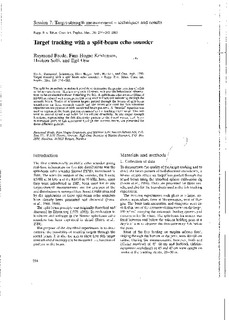| dc.contributor.author | Brede, Raymond | |
| dc.contributor.author | Kristensen, Finn Hogne | |
| dc.contributor.author | Solli, Haakon | |
| dc.contributor.author | Ona, Egil | |
| dc.date.accessioned | 2009-01-22T15:01:27Z | |
| dc.date.issued | 1990 | |
| dc.identifier.issn | 0074-4336 | |
| dc.identifier.uri | http://hdl.handle.net/11250/116854 | |
| dc.description | Int. Symp. on Fisheries Acoustics, Seattle, WA (USA), 22-26 Jun 1987 | en |
| dc.description.abstract | The split-beam technique makes it possible to determine the precise location of a fish in the acoustic beam. This is a very useful feature, as it permits behavioural observations to be conducted without disturbing the fish. A split-beam echo sounder (Simrad ES400) interfaced with a computer has been used to track fish swimming through the acoustic beam. Tracks of reference targets guided through the beam of split-beam transducers on three research vessels and the transducer used for fish-behaviour experiments are presented with associated beam patterns. A "belt-fit" equation was used to represent the beam pattern measured in the tracking experiment. This was used to correct signal amplitudes for transducer directivity. In situ target-strength functions, representing the fish directivity pattern in the dorsal aspect, and three-dimensional plots of fish movement through the acoustic beam, are presented for three different gadoids. | en |
| dc.format.extent | 1065166 bytes | |
| dc.format.mimetype | application/pdf | |
| dc.language.iso | eng | en |
| dc.publisher | ICES | en |
| dc.title | Target tracking with a split-beam echo sounder | en |
| dc.type | Conference object | en |
| dc.source.pagenumber | 254-263 | en |
| dc.source.volume | 189 | en |
| dc.source.journal | Rapports et Procès-Verbaux des Réunions | en |
